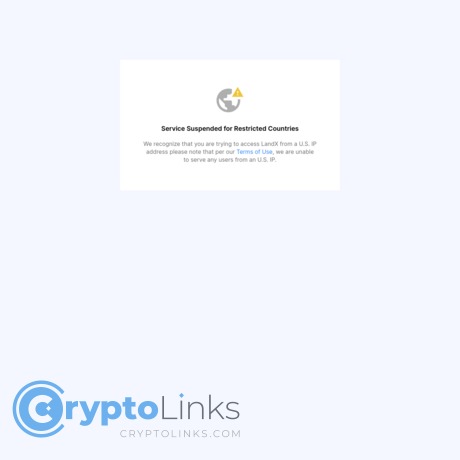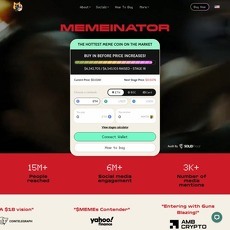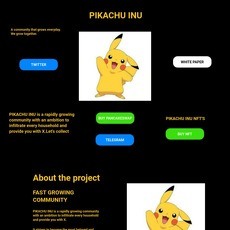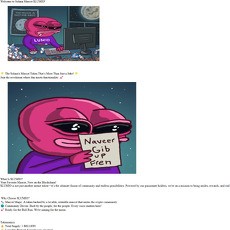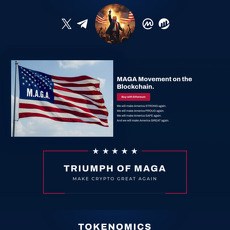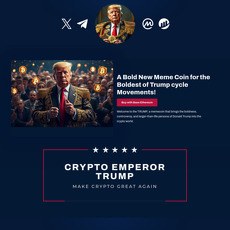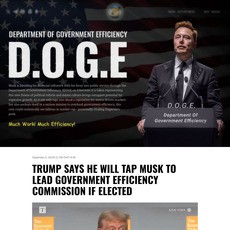LandX Review
LandX
landx.fi
If your website is on the scam list and you think that you are not a scammer, contact us. After you provide us with all the proof that you are in Crypto World with good intentions, we will delist you. Usually, you get in this category because you are hiding your team, you have a bad reputation(you are tricking, deceiving, scamming people), and you haven't got a written project whitepaper or is a shitty one....
Their Official site text:
LandX Litepaper
Introduction to LandX
LandX is a decentralized protocol closing the gap between farmland owners and crypto investors through blockchain-based perpetual commodity vaults.
What is a perpetual commodity vaults?
The LandX protocol enables an agreement between borrowers (farmers) and investors. The vault acts as a blockchain-based token that trades for a market-determined principal price. The holder of the staked token receives a daily yield of the underlying commodity in perpetuity.
What is a blockchain-based decentralized protocol?
LandX is built on the Ethereum blockchain, meaning all transactions reach consensus through a peer-to-peer system. There is no third party needed for any financial transaction (token trade). The LandX code is autonomous and executes on Ethereum in a permissionless manner.
What problems does LandX solve?
LandX is a decentralized system to reduce the impacts of food scarcity and instability on a local and global scale. To incentivize participation in this system, we solve meaningful problems for both farmers and investors:
For farmers:
Farmers often experience difficulties accessing capital. There are several reasons for this:
Financing for agricultural purposes is administratively difficult
The ability to access capital is location dependent
The available options are often unfavorable
Farmers want capital to purchase additional farmland, new equipment, and facility updates. These efforts contribute to local food security in a direct way, but can’t be accomplished without liquidity.
The LandX protocol solves farmers’ financing difficulties by providing upfront capital in exchange for a percentage of their land’s future harvest. Simply put, farmers use LandX to tokenize a portion of their future crops to receive money today.
For investors:
Investors in the traditional markets have access to several commodity derivatives products. The most frequently traded of these are futures contracts and options on futures contracts.
Despite these products, investors have no way of gaining exposure to the output of real-world farmland. LandX’s commodity vaults provide investors a daily yield paid out in units of the underlying commodity. LandX participants are also exposed to commodity prices through fluctuations in its vault's principal trading price..
Crypto-native investors have very few on-chain commodity derivative choices. Most investment portfolios in the space remain highly correlated to the cryptocurrency and stock markets. Additionally, blockchain-based investors, treasuries, and DAOs are always in search of sustainable yield. LandX alleviates both dilemmas:
Portfolio diversification through exposure to uncorrelated assets
Daily yield paid out in units of a commodity and claimable in USDC
Nobody is offering fractionalized on-chain exposure to farmland crop-share. LandX is, through a diversified, dividend-bearing product for all investors.
How does LandX work?
There are three participants in the LandX system:
Farmers commit their land’s crop share to LandX to access capital from investors. Their commitment is secured by a lien on the underlying farmland.
Validators are the bridge between farmers and the protocol. They’re responsible for onboarding new farmers and assisting with the process’s legal and economic contracts.
Investors deploy capital in exchange for exposure to real farmland assets through perpetual commodity vaults known as xTOKENs.
The LandX process begins with farmers committing a portion of their land’s crop-share through a legal contract known as a lien. Their farmland is also subject to an extensive qualification process to ensure its reliability. The resulting legal and economic contracts are represented by an NFT. The NFT is fully backed by the underlying farmland.
In exchange for committing their signed contract (NFT), farmers receive xTOKENs equivalent to the crop-share they agreed to (i.e. if a farmer commits 1000kg of soybeans per year, they receive 1000 xSOY tokens).
The LandX platform requires farmers to keep 12 months of crop share payments on the platform in order to hedge against potential crop or cash uncertainties. Additionally, LandX requires a 12 month security deposit from every farmer.
To access the upfront capital, farmers sell their xTOKENs on-chain to interested investors. Their farmland’s output is then given to xTOKEN holders. Each xTOKEN entitles its owners to receive 1 kg per year of the commodity yield (CY) in perpetuity, paid out in cTokens.
cTokens can be sold at the protocol level for USDC at the current market price of the commodity delivered by a Chainlink oracle.
The LandX protocol pays xTOKEN holders the daily commodity yield guaranteed by the farmer’s contract. Investors can claim their CY in cTokens and convert it into USDC at any time.
If a farmer wants to exit their crop-share obligation, they must buy back the xTOKENs they originally received. Once the xTOKENs are returned to the smart contract, the NFT commitment will become void.
xTOKENs
xTOKENs are the perpetual commodity vaults that make this on-chain arrangement possible. They’re liquid, tokenized derivatives tradable on the Ethereum blockchain.
As mentioned, xTOKENs represent 1 kg/year in an underlying commodity. If someone holds xWHEAT, they receive 0.0027 kg of wheat per day, equating to 1 kg/year. The CY is paid out daily in units of the underlying commodity (kilograms). When an xTOKEN holder wants to claim their rewards, the value of their CY is converted to USDC and given to the holder.
xTOKENs benefit investors in several ways:
Hedge against inflation: xTOKENs offer exposure to the crop output of farmland, which has historically been a dependable inflation hedge.
Liquid, income-producing asset: xTOKENs make farmland commodity vaults tradable 365 days/year on decentralized exchanges.
Collect daily yield in USDC: Crop yield is added daily and can be claimed anytime in USDC.
Portfolio diversification: xTOKENs provide an uncorrelated diversification from crypto, stocks, and traditional vaults.
cTOKENs
1 staked xWHEAT token will earn 1 cWHEAT per year which can be traded for the market value of 1KG of wheat. cTokens are tradeable via an internal marketplace which collects landowner yield in USDC and offers it at market value for cTokens.
cToken exchange prices are updated via a Chainlink oracle which uses pricing data from traditional finance exchanges.
LNDX Token
While the xTOKEN represents perpetual commodity vault, LNDX is the native token of the LandX protocol. The price of LNDX is driven by speculation and the performance of LandX as a company. Its price is also impacted by the demand to participate in LandX’s system.
Here’s how LNDX is tied into the protocol:
The LNDX token receives a percentage of the protocol’s revenue. As a result, it’s partially represented by the intrinsic value of LandX.
LNDX holders vote on governance decisions for the platform, future updates, and more. It’s an integral piece of the LandX DAO.
LNDX stakers are eligible to become validators for LandX. To refresh, validators have the responsibility of onboarding farmers to the protocol and receive a commission in return. Additional conditions apply to becoming a validator.
Investment Case Example
An investor wants to purchase $1M of the protocol’s Soybean vault xSOY. In exchange for their investment, they receive 100,000 xSOY tokens, priced at $10 each. The xSOY tokens represent 100,000 kilograms of Soybeans each year.
Along with owning commodity vault that represent 100,000 kilograms of soybeans per year, the holder also earns an approximately 7% annual percentage rate (APR) as the CY. Once the CY (1 kg/yr) is claimed for USDC, the 7% is realized.
To summarize, the investor captures:
~7% commodity yield
Appreciation of the commodity yield as the underlying commodity price increases
Appreciation of the xSOY vault as the commodity price increases
The scenario creates a leveraged upside while at the same time providing a hedged downside.
If Soybeans appreciate by 15% over the next year, and the investor sells their $1M position, they’ll profit approximately $230,500 (23.05%).
If Soybeans drop in price by 15% over the next year, and the investor sells their $1M position, they’ll only realize a $95K loss (-9.5%).
This is an asymmetric opportunity in an asset class that blockchain-based investors do not currently have access to. If the price goes up, you get the increase in xSOY and the yield. If the price goes down, some of your losses in the value of xSOY are offset by the daily yield you receive.
Impact of LandX
Many DeFi applications advertise unsustainable yield through inflationary tokens and marketing dollars as an effort to incentivize liquidity.
LandX creates sustainable yield built upon regenerative finance. Capital is used as a tool to invest in real-world yield opportunities and solve systemic issues to regenerate natural environments. LandX believes in providing financial flexibility to farmers, while creating new primitives in decentralized finance that offer access to a dependable asset class.
The LandX protocol is a bridge between real world assets and blockchain technology. Farmers are able to enter agreements with investors on a global scale and receive capital for business expansion and long-term food security efforts. LandX created a robust legal and financial framework to connect farmers and investors in a brand new way.
Future of LandX
The LandX protocol currently accepts land with crop-share denominated in corn, soybeans, rice, and wheat.
Along with horizontal growth in crop-share opportunities, LandX will also work toward opportunities for composability within DeFi. LandX tokens will integrate with a variety of decentralized applications for short term borrowing/lending, auto-compounding of yield, and more.

